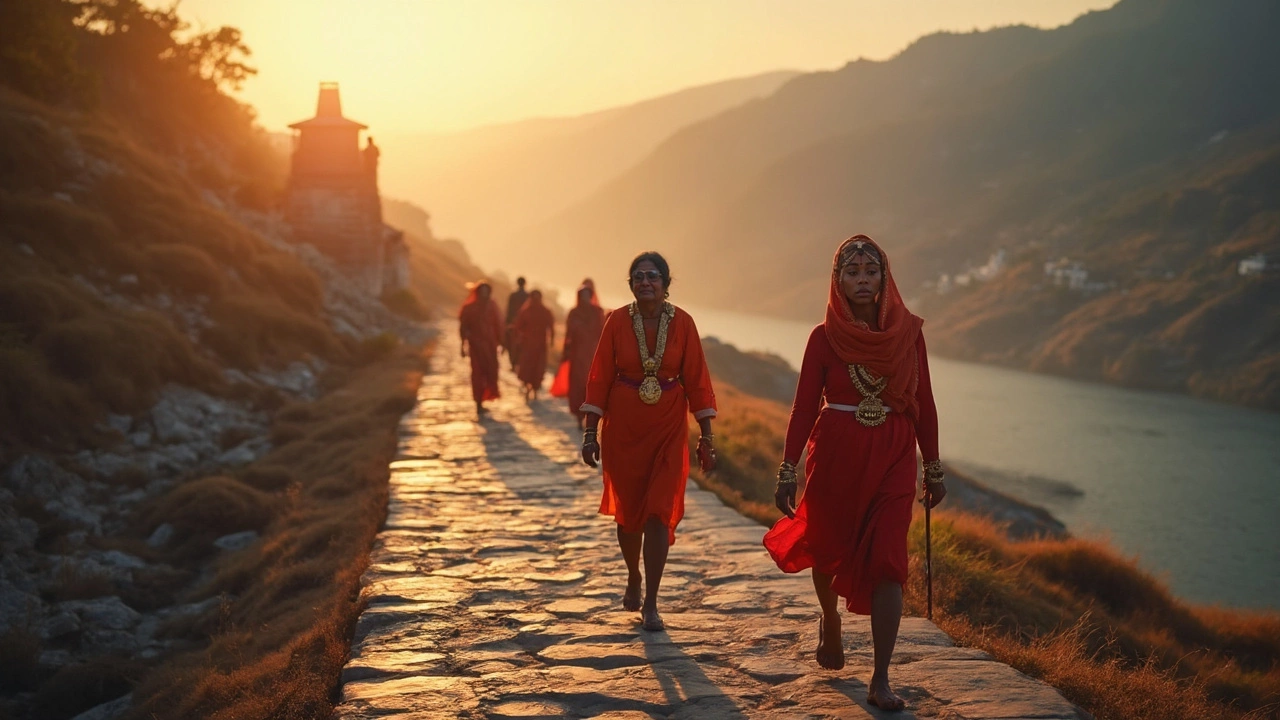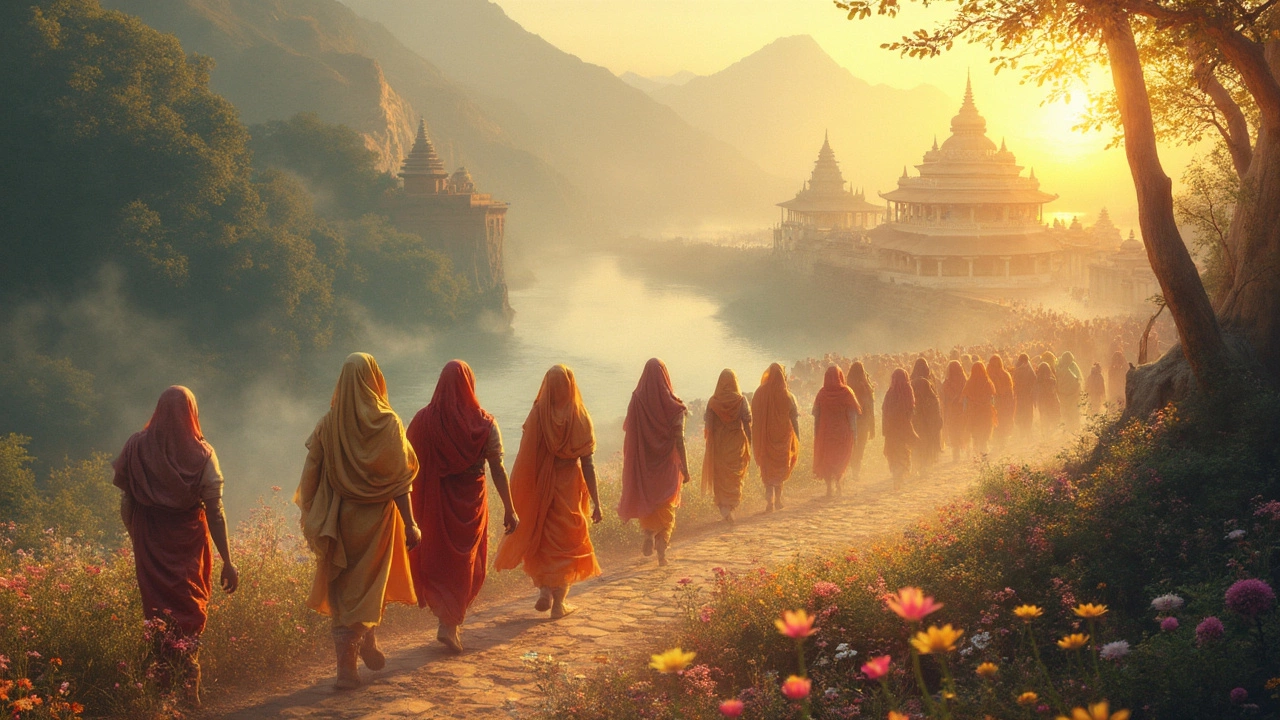India's 4 Dham, literally 'four abodes', are not just places on a map – they are spiritual lodestones. Situated in key corners of the country, these spots are Kedarnath, Badrinath, Yamunotri, and Gangotri. Together, they form a pilgrimage circuit that has drawn devotees for centuries. Any guesses why they're so important? Well, each Dham is believed to be devoted to a specific deity, embodying unique religious vibes.
These holy sites aren't just for the devout – they're a feast of culture and history, too. If you're wondering when to pack your bags, the best time to visit varies depending on the local weather. Before you head off, brushing up on a bit of history and planning your logistics can make all the difference. We'll get into that and much more to make your journey unforgettable.
- Introduction to the 4 Dham
- Significance of Each Site
- Travel Tips and Best Times to Visit
- Unique Features and Facts
Introduction to the 4 Dham
The mysterious allure of the 4 Dham in India is embedded in Hindu tradition, offering a path to spiritual enlightenment. This pilgrimage circuit is often called the Chota Char Dham, different from the more extensive Char Dham circuit established by the philosopher Adi Shankaracharya. Let's dive into what's so special about them.
The Northern Abode: Kedarnath
Perched in the Garhwal Himalayas, Kedarnath is dedicated to Lord Shiva. Its dramatic backdrop of snow-capped mountains sets a breathtaking stage for the ancient Kedarnath Temple. This site is often seen by pilgrims as a step into the spiritual realm – according to legends, it's where Lord Shiva decided to reside in the form of a linga.
The Eastern Light: Badrinath
Next up is Badrinath, which honors Lord Vishnu. Nestled between the Nar and Narayana mountain ranges, this sacred spot is said to be one of the holiest places for Hindus. Pro tip: Plan your visit between May and October, when the temple is accessible and the weather is more forgiving.
The River Origins: Yamunotri and Gangotri
Yamunotri and Gangotri are famous for their association with India's revered rivers, the Yamuna and the Ganges. Yamunotri, dedicated to Goddess Yamuna, is lesser-known but equally enchanting. Meanwhile, Gangotri boasts a revered temple where the river Ganges is worshiped as both a goddess and a life-giving force.
Wondering how these places fit together in a pilgrimage plan? Here’s a quick view of the route:
- Kedarnath - Begin in the majestic mountains.
- Badrinath - Shift to the colorful valleys.
- Yamunotri - Experience the serene beginnings of a river.
- Gangotri - Conclude with the sacred waters of Ganga.
The trek isn't for the faint-hearted, but those who make the journey find it deeply rewarding. It's about more than just visiting a few temple tours, it's about connecting with India's soul, one profound stop at a time.
Significance of Each Site
Each of the 4 Dham holds a special place in the hearts of Hindus, not just in India but around the world. They're spread across the country's unique landscapes, each with its distinct charm and spiritual aura. Let's dive into what makes each of them so unique.
Kedarnath
Nestled in the Garhwal Himalayas, Kedarnath is dedicated to Lord Shiva. It's one of the 12 Jyotirlingas, making it a high-priority spot for Shiva devotees. The vibes here are supercharged, partly because of its remote location. People believe that a trek to this temple cleanses sins and opens up a new path to salvation.
Badrinath
Badrinath, dedicated to Lord Vishnu, is situated between the Nar and Narayan mountain ranges. Imagine a spot so divine that it changes its clothes with the seasons—Badrinath's deity is adorned differently in winter and summer! The temple is all about Vishnu's devotion, offering a peek into ancient rituals still practiced today.
Yamunotri
This one isn't just a feast for the eyes; it's where the Yamuna River, considered sacred, originates. Dedicated to Goddess Yamuna, visiting Yamunotri is believed to protect against untimely death. It's a trek to get there, involving natural hot springs perfect for a dip that's both practical and spiritual.
Gangotri
As you probably guessed, Gangotri is the seat of Goddess Ganga. This is where the holy Ganges River touches down to earth. The temple offers an awe-inspiring blend of spirituality and nature. Open your eyes early in the morning, and you might catch the soul-soothing rituals performed along the riverbanks.
If you're planning a visit, jot down that these sites are generally open from late April to early November when the paths are clear of snow and the temples are accessible. Pilgrim queues can be daunting, so an early morning start is wise.
| Dham | Opens | Peak Visit Time |
|---|---|---|
| Kedarnath | April | May-June |
| Badrinath | April | May-June |
| Yamunotri | April | May |
| Gangotri | April | May |

Travel Tips and Best Times to Visit
Planning a trip across the 4 Dham can be super rewarding if you time it right. Here's the lowdown to make the most of your spiritual journey.
When to Go
The best time to visit the 4 Dham is generally from May to June and September to October. This is when the weather is pleasant and paths are accessible. The monsoon season can make things tricky with landslides and road blockages – something to avoid.
Kedarnath and Badrinath open in April or early May each year and close around November because of the heavy snowfall. Visiting in peak summer also means you won't freeze!
Travelling Smart
- Book accommodations in advance, especially during peak pilgrimage season, to make sure you have a comfy bed waiting after a day's trek.
- Carry light woolens at all times; even summers can throw in chilly breezes up in the mountains.
- It's wise to check weather forecasts regularly to avoid bumps in the road, literally and figuratively.
Getting There
Most journeys start from Haridwar or Rishikesh for Yamunotri and Gangotri, and from Dehradun for Kedarnath and Badrinath. Domestic flights, trains, and buses are available to these gateway cities. Once there, taxis and shared jeeps provide the way forward to reach each Dham.
| Dham | Gateway City | Travel Method |
|---|---|---|
| Yamunotri | Rishikesh | Bus/Jeep |
| Gangotri | Rishikesh | Bus/Jeep |
| Kedarnath | Dehradun | Helicopter/Jeep |
| Badrinath | Dehradun | Bus/Jeep |
Making sense of travel options before you start can save a bunch of headaches later. Remember, a little planning goes a long way to ensuring a smooth and spiritually enriching experience through the temple tours of India.
Unique Features and Facts
Let's dive into what makes the 4 Dham circuit so unique in the vast tapestry of India pilgrimage. Each site has its own charm and historical quirks that set it apart.
Badrinath
Did you know that Badrinath is dedicated to Lord Vishnu? It's nestled in the Garhwal hills, at a whooping elevation of 3,300 meters! The temple is said to have been established by the sage Adi Shankaracharya in the ninth century. And guess what? It’s only open for six months a year, from April to November, so plan carefully if you want to visit.
Kedarnath
Kedarnath is all about Lord Shiva. This temple is part of the Chota Char Dham of Uttarakhand, and it's the highest among the 12 Jyotirlingas, perched at an altitude of over 3,500 meters. Historically, it's fascinating because it was mentioned in the Mahabharata as where the Pandavas sought Lord Shiva’s blessing.
Gangotri
Gangotri is where the Ganges comes alive. This site is linked to the Goddess Ganga, who descended from heaven to earth here. The temple's glaciers are a sight to behold, usually drawing eco-lovers and spiritual seekers. The Gangotri Glacier is the primary source of the revered river, making it a significant draw for pilgrims.
Yamunotri
At Yamunotri, you'll find devotion to Goddess Yamuna. The temple is at the river's source and offers thermal springs where visitors can soak their feet. One of the unique traditions here is cooking rice in these hot springs, which locals and pilgrims sometimes do to offer to the deity.
Interesting Facts
- The 4 Dham sites are part of the larger Char Dham circuit, but the Char Dham in the context of all India refers to Badrinath, Dwarka, Puri, and Rameswaram, located at the four corners of India.
- The path to each Dham is as varied as their altitudes, with lush green forests leading to Badrinath, and the stark, chilly mountain terrain to Kedarnath.
- The annual footfall of pilgrims often exceeds a million, providing local economies with a significant boost.
